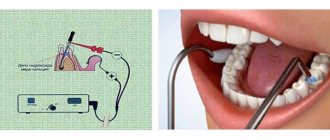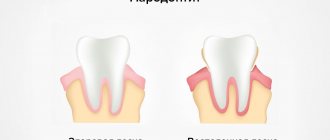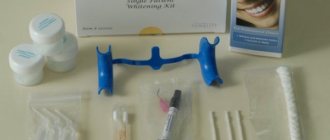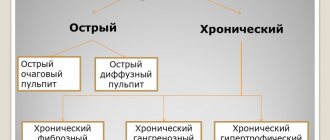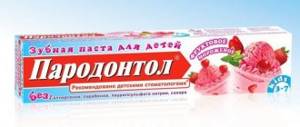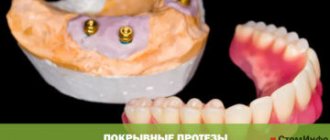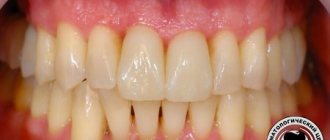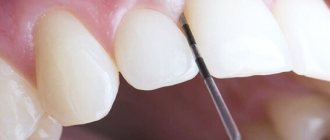From this article you will learn:
- treatment of gums with the Vector device – reviews from a practicing periodontist,
- Vector device for the treatment of periodontitis – price for 1 tooth for 2021
The article was written by a practicing periodontist.
The Vector device in dentistry is an ultrasonic device for removing dental plaque in dental practice. There are 2 modifications of this device, of which we are interested in the “Vector Paro”, because It is precisely this that is positioned by the manufacturer as an innovative remedy in the treatment of periodontitis. The second device is the “Vector Scaler”, which is no different from conventional ultrasonic scalers used to remove hard dental plaque.
This equipment is manufactured (Germany). In this article we will examine in detail whether the removal of subgingival dental plaque with the Vector device is really so effective. We will also present clinical studies comparing the effectiveness of therapy using the Vector device with the effectiveness of traditional ultrasonic scalers.
What does the Vector Paro device look like?
In the last few years, it has also released a new device called “Vector Paro Pro”. This device combines both “Vector Paro” and “Vector Scaler” in one housing. The latter is even very necessary, because to remove massive supra- and subgingival dental plaque - at stage 1, in any case, we must first use only conventional ultrasonic teeth cleaning (in combination with Air-Flow - for final polishing of teeth).
And only at stage 2 we will move on to the use of the Vector Paro device, designed to remove subgingival dental plaque and finely polish the surface of the teeth roots (in periodontal pockets). And for this we will no longer use ordinary water, which is used during the operation of traditional ultrasonic scalers, but a special polishing liquid, which is a suspension based on hydroxyapatite and calcium phosphate.
About the invention
The Vector device was invented by DURR DENTAL, which was founded by two brothers Wilhelm Duerr and Karl in the town of Stuttgart-Feuerbach. In 1941, it was a small workshop in which young people made parts for use in precision mechanics devices.
Today the company specializes in the development of systemic medical solutions, has its head office in Bietichheim-Bissingen (Germany), employs more than 1,000 people and has representative offices in 36 countries. In 2015, the company's turnover was approximately 240 million euros.
Vector consists of two devices: one is the Vector Paro, which is an innovation for the treatment of periodontitis, and the second is the Vector-scaler (scaler), which is a common device in medical equipment.
Vector Paro has an interesting design, which makes it unique. To remove deposits from the gums, a special attachment has been created that works not horizontally, but vertically, which minimizes the negative impact of the device on the roots of the teeth and prevents damage to the tooth surface.
A special feature of the Vector system is that instead of distilled water, a special Fluid Polish solution is used during ultrasonic cleaning. It reduces tooth sensitivity and improves root planing procedures.
The operating principle of the device is based on ultrasonic technology. Ultrasound destroys stones under the gums and easily penetrates the most inaccessible places, thanks to the elimination of bacterial film.
“Vector” provides painless cleaning of periodontal pockets, non-traumatic cleaning of teeth from stones and rapid elimination of deposits at the roots.
Technical characteristics and features of the device:
- ultrasonic vibrations 25000 Hz;
- angle of change in direction of oscillations 90 degrees;
- amplitude of movement of instruments 25–35 µm;
- ultrasonic energy is transmitted using a water shell that surrounds the nozzle;
- there is no aerosol effect;
- no oscillating or vibrating uncontrolled movements;
- no nozzle heating.
Operating principle of the device
Vector is a scaler (scaler) - a device for removing tartar; the principle of its operation is based on the action of ultrasound on hard deposits and soft plaque, while the gums and tooth enamel do not experience any stress due to the use of a liquid medium during operation of the device. Ultrasonic vibrations of a certain frequency destroy dental deposits and microbial biofilm, gentle polishing of tooth enamel occurs, and at the same time the remaining contaminants are washed away. After removing hard deposits and microbes, the condition of the gums is restored and inflammation goes away.
The Vector device is a modern ultrasound system, improved compared to traditional ultrasound machines. The frequency of the ultrasonic waves of the device is 25 kHz, and their movement is not multidirectional, as in other devices, but is directed parallel to the long axis of the tooth (hence the name of the device - “vector” - bearing the direction). This feature is realized thanks to the tip with a resonant ring.
There are two types of devices: Vector Scaler - a device with a regular tip, and Vector Paro - in addition to the usual scaler tip, the kit includes an innovative Paro tip, which allows you to work not only with water, but also with polishing liquid. When using the Paro tip, linear vibrations are created, located vertically to the longitudinal axis of the instrument, the liquid flows in a pulsating stream.
Due to the parallel direction of the ultrasonic wave, when removing bacteria and plaque from the surface, the roots of the teeth do not experience unwanted stress.
The device is supplied with Vector Fluid Polish, a set of tools and attachments, a container for sterilization, and a set of tools for servicing the device.
Before starting the procedure, a special treatment mixture is applied to the nozzle, which contains particles of hydroxyapatite (calcium, similar in composition to enamel). The mixture also includes antiseptic bactericidal components that promote gum healing.
Difference between Vector therapy and surgical curettage
Periodontal diseases are caused by the presence of a bacterial biofilm that is resistant to antibacterial drugs.
A bacterial biofilm is a complex living organism with its own internal connections and colonies.
Before treating periodontitis, the microbial film must be removed mechanically.
Treatment with the Vector device
Even the name “Vector” suggests that its action is similar to a mathematical vector, narrowly directed to the point of influence.
The cleaning mechanism of the device creates a layer of hydraulic solution through which an ultrasonic signal is transmitted to the desired area of the tooth. Ultrasound fluctuations are set depending on the complexity of the problem and the characteristics of the disease.
Features of the device:
- modified linear ultrasonic vibrations;
- hydrodynamic impact;
- indirect effect on solid structures.
When using vector technology:
- there is no mechanical damage to the tooth and root due to gentle and atraumatic removal of biofilm. The doctor does not scrape the surface of the root, but moves the instrument from the outside to the bottom of the pocket, working along the root;
- the patient does not feel pain during the procedure.
How the classic method works
During mechanical manual curettage, in response to an irritant, the body activates a protective immune response. Therefore, the process is complicated by the presence of bleeding, the appearance of supragingival dental plaque, pathological traumatic occlusion and open dentinal tubules. Complications such as gum recession and lysis of bone structures are possible.
Thanks to scraping:
- a glassy surface is formed;
- possible damage to root cement;
- All structures important for regeneration are disrupted.
Therapy Vector in dentistry: video
In the videos below you can see exactly how Vector therapy is performed in dentistry. These are promotional videos, but they clearly demonstrate the peculiarity of the procedures on the Vector Paro device. Further in the article you will be able to see several more videos that clearly show how teeth are cleaned in the oral cavity with Vector.
Comparison of the effectiveness of periodontitis treatment with conventional ultrasonic scalers and the Vector device -
The largest scientific library MEDLINE-PubMed and the Cochrane Central Register of Controlled Trials have more than 270 scientific articles that compare the quality of plaque removal from periodontal pockets with the Vector system versus their removal with conventional ultrasonic scalers. Below we present the results of several independent studies, the funding of which was not associated with the manufacturer of the Vector system.
- Clinical study “Efficiency of subgingival calculus removal with the Vector-system compared to ultrasonic scaling and hand instrumentation in vitro.” Authors: Braun A., Krause F. and others.
We quote the results: If a special abrasive liquid was used in the treatment of periodontitis using the Vector device, and the removal of subgingival calculus was carried out using metal attachments (and not carbon fiber, which are also included in the set) - the quality of tartar removal was as effective as when using conventional ultrasonic scaler.Thus, the researchers do not see any particular differences between these methods, and note that in a number of cases (if the doctor chooses the wrong attachments for the Vector, as well as in the absence of the use of a special polishing fluid “Vector Fluid polish”), the effectiveness of removing tartar will be worse than when using conventional ultrasonic scalers.
- The clinical study “The use of a linear oscillating device in periodontal treatment: a review” by Guentsch A. and Preshaw PM showed the following results. We quote the conclusions of the researchers: “The Vector system in the treatment of chronic periodontitis leads to clinical and microbiological results comparable to those achieved using hand instruments and conventional ultrasonic instruments.”
In addition, Vector is less effective at removing large amounts of plaque and is therefore best used for maintenance rather than primary treatment (as it is better tolerated by patients and results in less root cement removal than other methods of scaling ). And patients with periodontitis just need regular maintenance courses of therapy.The study reports similar microbiological results - meaning that regardless of the use of the Vector or the ultrasonic scaler - the periodontal pockets will have the same composition of pathogenic bacteria after treatment. In fact, this is a very important point, which finally puts an end to the question of the higher efficiency of Vector over other ultrasonic methods - it simply does not exist.
- Scientific article “Which type of scaling system is best?” (translated as – “Effects of the Vector system on human teeth: a systematic review” published in the International Journal of Dental Hygiene. Author Ivan Darby. 270 studies were selected that compared the Vector with traditional ultrasonic scalers, but only 15 of them were included in the review, t .as only they met strict standards and had no commercial conflict of interest.
Conclusions: “The Vector device for the treatment of periodontitis provided comparable results (we are talking about the quality of tartar removal and the degree of polishing of the root surface) - as well as a conventional ultrasonic scaler.” The advantage is given only in the following: the effect of the Vector device on the tooth is less, which is expressed in less damage to the cement of the tooth root during the procedure for removing subgingival dental plaque.
Is high-quality removal of subgingival tartar important for the treatment of periodontitis?
Periodontitis develops due to poor oral hygiene, when soft microbial plaque and tartar remain on your teeth. The presence of the latter leads to the gradual destruction of the periodontal attachment, destruction of the bone around the tooth, and as a result, so-called “gingival pockets” (periodontal pockets) are formed between the gum and the root surface. In such pockets, subgingival tartar is already formed, which stimulates further destruction of the attachment of the tooth to the bone tissue.
In Fig. 7-8 below you can see what periodontal pockets with subgingival calculus look like. The first photo was taken before the open curettage operation, and note that before the detachment of the soft tissue of the gums, it says absolutely nothing that a large volume of bone tissue has been destroyed inside and there is subgingival tartar. But you can clearly assess the true depth of the periodontal pocket and the presence of subgingival tartar on the surface of the tooth root in the second photo (taken after gum detachment).
Subgingival calculus –
So, if such tartar is not removed, then the destruction of the bone and periodontal attachment will continue and will progress until the tooth becomes mobile. In the future, the mobile tooth will simply have to be removed, because there will not be enough bone to support the tooth. Therefore, it is very important to remove not only visible supragingival dental plaque, but also subgingival tartar.
And at this stage it doesn’t even matter whether it’s a Vector or an ultrasonic scaler, because there really isn't much of a difference between the two (although there is still a difference in some situations!). You should also understand that treatment of periodontitis does not end with the removal of subgingival dental plaque and anti-inflammatory therapy. In the presence of medium and deep periodontal pockets, the main method of treatment is open curettage or flap operations (i.e., radical treatment is possible only with the use of surgical techniques). But why? - you ask.
System advantages
The Vector device has many advantages over other scalers, which explains its popularity among dental clinics recently.
The advantages of the device are the following:
- Ability to perform highly professional hygiene. Vector's power technology helps target the hardest to clean areas of the tooth and stubborn sub-gum deposits.
Professional hygiene also means that during cleaning a special solution is used to help reduce pain during periodontitis treatment. Fluid Polish suspension polishes teeth and their roots, reduces tooth sensitivity. - Treatment of periodontitis. Thanks to its thin tools and special arrangement of nozzles, Vector eliminates deposits and bacterial biofilm, which are difficult to clean with conventional scalers.
The device is able to penetrate into any point of the problem cavity, starting from the surface of the roots, periodontal pockets, and ending with areas that are anatomically located in hard-to-reach places.Ultrasonic technology allows you not to damage soft tissues by scraping, but to perform the latest delicate cleansing.
- Complete elimination of the disease. By using the device on a regular basis, the frequency of which is determined by your doctor, you can prevent the recurrence of periodontitis.
- No infection or inflammation. The action of the device combats inflammatory processes and infection of periodontal pockets.
- Fast recovery. The patient’s soft tissues quickly recover after the procedure, and pain, most often, does not bother him. This effect is due to the action of a suspension that includes hydroxyapatite.
Treatment with Vector ultrasound energy has its advantages. The technology is designed in such a way as to completely relieve the patient from the disease and maintain a healthy oral cavity.
What is Vector
“Vector” is an ultrasonic device developed by German scientists at Durr Dental to remove all types of bacterial deposits from the oral cavity (soft and hard mineralized plaque). With its help, a thorough treatment of the teeth, the space above and below the gums (in periodontal pockets) is carried out.
In fact, Durr Dental supplies the medical services market with a whole complex consisting of several devices:
- Vector Scaler: a regular ultrasonic scaler (scaler), no different from many devices from other manufacturers. Used for professional hygienic cleaning in a dental office,
- Vector Paro: is positioned by the manufacturer as a tool that helps in the treatment and prevention of periodontal diseases. Promotes high-quality and complete removal of plaque not only from all visible surfaces (teeth, gums), but also from under the gums, and it is subgingival deposits that are the main provocateurs of inflammation in periodontal tissues. Vector Paro is of practical interest to specialists, and therefore is mostly used in dental clinics. We will talk about its features further.
Indications
“Vector” is a device of broad specialization, aimed primarily at the treatment of periodontal diseases.
Indications for using the device’s technique are as follows:
- Generalized periodontitis (chronic) during periods of exacerbation and remission. Degrees: easy, medium and heavy. Maintenance therapy.
- Ulcerative-necrotic gingivitis (hypertrophic and catarrhal).
- Gingivitis during pregnancy.
- Peri-implantitis.
- Periodontal diseases caused by cardiovascular pathology, diseases of the endocrine system, oncology, etc.
- Occupational hygiene for patients who have implants installed.
- Professional hygiene for patients with braces.
Do you know what macroglossia is in newborns and adults?
We bring to your attention here everything that you still do not know about cementome.
At this address https://www.vash-dentist.ru/detskaya-stomatologia/polost-rta/stomatit/kataralnyiy.html we will talk about the modern treatment of catarrhal stomatitis.
Information about disadvantages
As for the disadvantages, they also exist. Ultrasonic teeth cleaning using the Vector device is a procedure that has a fairly high price.
The manipulation is also not suitable for all clinical cases. For example, deposits that are too deep cannot be removed using the device. Patients with a similar problem will have to undergo surgical measures that involve peeling off the gums and suturing at the final stage of cleaning, as well as a long rehabilitation period.
Cleaning with the Vector device is not a panacea. As an independent measure, the procedure will not get rid of gingivitis and periodontitis. You need to understand that these diseases are treated with a whole range of measures.
Contraindications
There are also contraindications to the use of Vector, including:
- diabetes mellitus (unregulated and decompensated glucose levels in humans);
- myocardial infarction suffered over the past six months;
- undergone internal organ transplantation (for consultation you should contact the appropriate attending physician);
- a pacemaker installed in a person (old type);
- hematological diseases (blood diseases), such as leukemia, etc.;
- periodontal disease (is a relative contraindication);
- allergic reaction to Polishe Fluid and Abrasive Fluid components.
To avoid putting your body in danger, it is important to notify your dentist if you have one of the above problems.
Stages of the procedure
Treatment of periodontitis with Vector significantly simplifies the dentist’s task. The procedure is carried out in several stages and takes a minimal amount of time when compared with other treatment methods:
- First, the doctor conducts an initial examination and determines the severity of the disease, noting the characteristics of the stones, their exact location and the progression of the disease. The patient is assigned a day of treatment.
- On the day of treatment, a photograph of the oral cavity is taken so that the dentist can assess the real condition of the gums. This is especially necessary if the treatment requires drastic measures - surgery, but there is a chance to save the situation with the help of Vector.
- Oral hygiene is carried out. Professional hygiene is scaling. Using ultrasonic technology, the tooth is cleaned and polished.
- Next, the periodontal procedure itself is carried out. The thin tip of the tool penetrates to the root of the tooth, cleaning pockets and other difficult areas. The microbial film is removed and the root branching zone is treated. The surface of the roots is also polished with a liquid containing an active substance.
It takes 4-5 minutes to treat one tooth, and the entire session takes from 1.5 to 2 hours.
Sometimes the patient requires a repeat procedure to consolidate the result. It is carried out after some time as a preventive measure.
Article: The effectiveness of periodontitis treatment with the Vector device
Periodontitis occupies a significant part among diseases of the oral cavity. Various methods are used in the treatment of periodontitis, including cleaning of periodontal pockets using metal instruments, ultrasound, and treatment using an ultrasonic scaler. Cleaning with the Vector ultrasonic device is the most popular.
Equipment for the Vector device at the LECTA clinic in Mytishchi
This unique device is equipped with a special design that avoids the main problem of ultrasonic devices - the chaotic beating of the cleaning tool.
In addition, the use of a vector does not destroy the tooth surface and does not irritate the gum tissue with vibration.
Therefore, treatment of periodontitis with the Vector device is suitable for people with great sensitivity and a low pain threshold.
Features of the treatment of dental diseases with Vector
When treating a periodontal pocket, a therapeutic mixture containing very small particles of hydroxyapatite is applied to the surface of the working instrument. Thanks to ordered vibration in the ultrasonic field, deposits are removed from periodontal pockets and the tooth surface is polished.
The use of hydroxyapatite helps accelerate gum recovery after the procedure. It is important that the tip of the device does not heat up during the treatment process. Therefore, the use of coolant to periodically cool the tip is not required. This innovation eliminates the impact of the aerosol cloud of microbes on both the patient and the attending physician.
The Vector device does not take up much space and is equipped with a foot switch. The attachments are disassembled into separate parts, so they can be sterilized at a temperature of 134 degrees Celsius.
Ordered vibrations increase the depth of ultrasound penetration to 11 millimeters, which in some cases saves the patient from surgical intervention. In addition, such a depth of penetration is typical only for this device.
Therefore, we can confidently say that Vector is unique in the treatment of periodontitis.
Treatment of periodontitis with Vector in Mytishchi
The device is focused on the very cause of the disease. With its help, it is possible to remove biofilm, tartar, plaque and endotoxin. In addition, treatment with this German device will relieve the patient of harmful bacteria that cause periodontitis and other dental diseases.
The tip of the device is inserted parallel to the dental axis. This allows pulse vibrations to propagate towards the vertical dental axis by 90 degrees. Thanks to this effect, there is no mechanical contact with tooth tissues and the integrity of the tooth and the soft tissues that surround it is maintained.
Methods of using the Vector device
The device is equipped with many different attachments that are used both in the treatment of periodontitis and for its prevention. In advanced forms of periodontitis, the main symptoms of which are inflamed and heavily bleeding gums, tooth mobility and an unpleasant putrid odor, treatment begins with cleaning the subgingival teeth and polishing the tooth root.
Thanks to this procedure, tissues affected by bacteria are removed, the periodontal pocket is sterilized, after which the gums begin to fit tightly to the smooth surface of the root.
Treatment with the Vector device is also carried out at the early stage of periodontitis, where it is enough to clean the tartar and rinse the periodontal pockets to neutralize pathogenic bacteria. After this procedure, an improvement in the condition of the gums is observed, pain disappears and discomfort goes away.
Treatment of periodontitis with Vector is usually done without anesthesia. When cleaning periodontal pockets, there are practically no unpleasant symptoms or painful sensations. The procedure does not damage the condition of tooth enamel and does not affect further sensitivity of the gums.
Forecast
The procedure is considered successful if the following criteria are achieved:
- tooth mobility disappeared;
- the depth of the periodontal pocket decreased;
- bleeding and flow of pus stopped;
- There is no bad breath.
Therapy is repeated approximately once a month for 8 months or a year for the purpose of prevention, or if the disease has complications. Sometimes one session is enough to completely eliminate periodontitis, after which the patient only needs to appear for a routine examination.
After completing the full course of treatment, an image of the oral cavity will show that the general condition of the roots has improved, the gums have become stronger, and the teeth are less sensitive.
Recommendations to be followed after the procedure
As after any ultrasonic cleaning, after manipulations with the Vector device, doctors recommend that patients adhere to several rules over the next 2-3 days:
- you need to refrain from eating food and drinks that are coloring, too cold and hot dishes, solid foods, sour and spicy foods,
- It is recommended to eat mainly soft and liquid foods,
- you shouldn't smoke
- Oral hygiene is best done with a brush with soft bristles and toothpaste marked Sensitive: after cleaning, it is important to purchase a new brush, since the old one harbors pathogenic bacteria.
2-3 months after the first procedure (or course of procedures), it is important to conduct a follow-up examination. Be sure to visit a doctor even though your gums begin to look healthy on the outside. Remember that achieving a lasting positive effect is possible only with subsequent maintenance therapy, especially in those patients who suffer from gingivitis and periodontitis.
Price
Each clinic sets the cost of using the Vector device in accordance with the stage of periodontitis in the patient.
If the patient comes to the clinic on time, then the procedure will be extremely simple for the doctor. The cost ranges from 500 to 700 rubles.
If the case is severe, then to use the device the doctor will need an assistant for at least 1, maximum 2 hours. This also affects the cost. The work becomes more complicated, which means the price increases to 1000-1400 rubles.
See photos of epulis on the gum and find out with us how dangerous it is.
This article contains true information about stomatitis - is it contagious, and how to protect family members.
Follow the link if you are unfamiliar with the methods of treating pericoronitis at home.
Dentist reviews
Most dentists have a positive attitude towards the Vector technique. The technique is completely painless, since the gum tissue is protected due to the fact that direct contact of the instrument with the problem area is carried out using ultrasonic vibration technology.
Some periodontists consider this device to be ordinary and do not distinguish it from other scalers.
The fact is that ordinary hospitals purchase equipment without spending a lot of money on additional attachments that simplify their work.
Standard attachments have a small amplitude of ultrasonic vibrations, so not all doctors are able to feel the power of the scaler the first time.
Analogs
Treatment of any stage of periodontitis begins with the elimination of deposits on the gums and stones on the teeth. In addition to scaler treatment, there are several other ways to get rid of the disease:
- Mechanical cleaning of pockets . Closed curettage without gum incision.
- Open curettage of periodontal pockets. When a deep depression forms in the pocket, surgical intervention is required to avoid complications.
- Elimination of other problems of the oral cavity. This may include replacing incorrectly installed fillings, crowns and dentures, which can cause deepening of pockets.
From the video you will learn about the advantages of the device and how the treatment is carried out.
Reviews
People who have already used the innovative Vector technology were satisfied with the technique, since painless treatment of a complex disease is a godsend for the patient.
You can also leave your feedback on eliminating periodontal disease using Vector in the comments to this article.
The use of Vector equipment is a breakthrough in periodontics, since the treatment of periodontal problems has never been so gentle and fast.
If you find an error, please select a piece of text and press Ctrl+Enter.
Tags gum treatment
Did you like the article? stay tuned
Previous article
Classification of dental caries according to the Black scale
Next article
Why does my teeth ache like crazy and how can I get rid of the pain?
Patient reviews
“Personally, the vector really helped me normalize the situation and transfer the disease to a stage of very long remission. Previously, I just did the cleaning, but now I go through the vector every six months. The procedure itself does not cause discomfort at all, and there is also no discomfort after it. I live and am glad that today there is technology that prolongs the life of teeth.”
Mari, review from 32top.ru
“I found out about Vector on the Internet and thought that it would save me from periodontitis, which I have been living with for many years. I found a clinic where they perform the procedure and made an appointment. After the examination, they said that it was too late, the teeth had become very mobile, the disease was too advanced... They recommended removal and implantation or simply removable dentures. Honestly, I don’t know how to react to this proposal, I’ll think about it!”
Olga T., 55 years old, review from woman.ru
